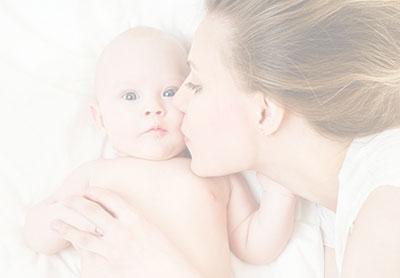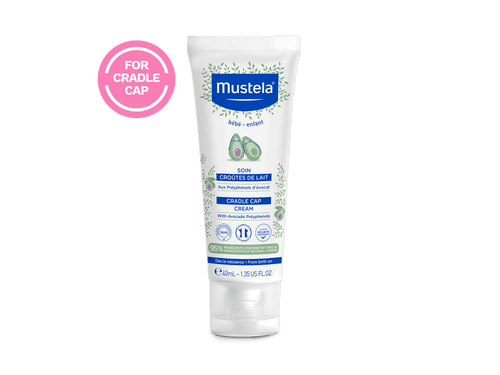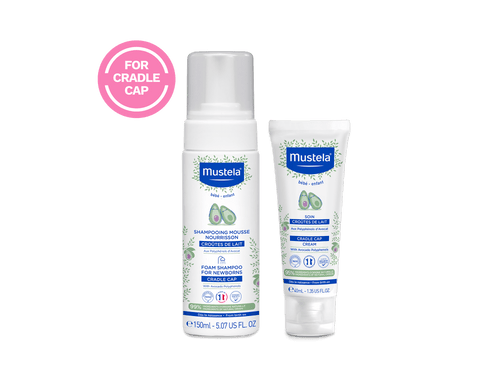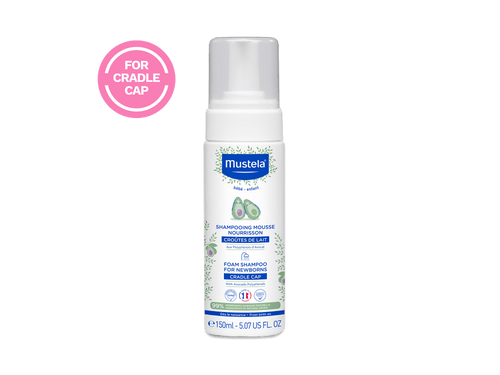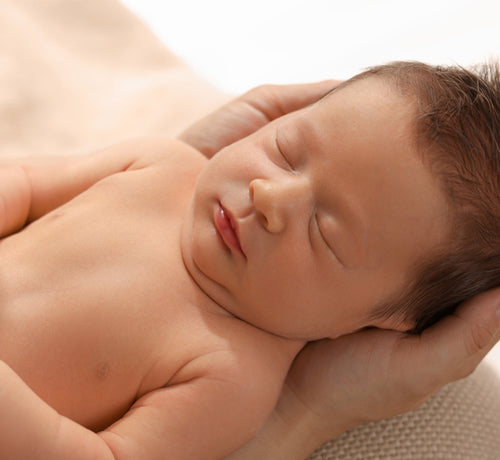Welcoming a baby into the world is both a wonderful and confusing time. Along with all the joy and love parenthood brings, there are many concerns you’ll face once your little one makes their appearance.
Your newborn can develop a number of deficiencies and conditions — from eczema to jaundice — and you may not know what they are or how to deal with them. One of those “What’s this here?” conditions is cradle cap.
But before you start to panic and rush your baby off to the emergency room, let the experts at Mustela put your mind at ease about this all-too-common skin condition. Along the way, we’ll answer questions such as:
- What is cradle cap?
- Should you be worried about cradle cap?
- How common is cradle cap?
- Is cradle cap painful or contagious?
- What does cradle cap look like?
- How can you tell cradle cap apart from other conditions?
- What causes cradle cap?
- Are there any tests for cradle cap?
- Does cradle cap have an odor?
- Can you pick your baby’s cradle cap?
After we answer the most common cradle cap questions, we’ll show you nine ways to prevent and treat this common skin condition.
What Is Cradle Cap?
Cradle cap is the common name for seborrheic dermatitis. We know those probably aren’t terms you come across every day, so allow us to elaborate. Here are the definitions you need to know:
- Seborrhea (seborrheic is the adjective form) — Overactivity of the sebaceous glands characterized by excessive secretion of sebum resulting in an oily coating, crusts, or scales on the skin.
- Sebaceous glands — Small glands in the skin that secrete a lubricating oily matter (sebum) into the hair follicles to lubricate the skin and hair.
- Dermatitis — A condition of the skin in which it becomes red, swollen, and sore. Usually resulting from direct irritation by an external agent or an allergic reaction.
Putting all that scientific jargon to work, it tells us that cradle cap is red (or yellow), irritated, oily skin that may form discolored, scaly, crusty patches. Still not 100% clear? In the simplest sense, it’s basically infant dandruff. However, dandruff shampoo isn’t the solution to the problem.
Strangely enough, cradle cap doesn’t just appear on the head. This is the predominant location, yes, but it can also flare up on your baby’s forehead, eyebrows, ears, diaper area, and other parts of their body.
Should You Be Worried About Cradle Cap?
The simple answer is NO. It’s completely harmless, not contagious, and usually disappears by your baby’s first birthday. One misconception about cradle cap is that it’s an indication of poor hygiene. This is false.
As you’ll see in the next few sections, cradle cap is the result of your baby’s body adjusting to its new environment. It’s also important to remember that this skin condition is very common. Doctors estimate that about half of all babies will exhibit some form of cradle cap during their first year of life.
That doesn’t mean you should just disregard cradle cap completely. Your baby’s body will usually work through the problem and stabilize itself on its own. In some rare instances, though, the scaly, irritated patches can get infected. This is most often due to excessive scratching from fingernails, clothing, or bedding. Again, infections are rare, but keep an eye on your baby’s cradle cap nonetheless.
Is Cradle Cap Painful Or Contagious?
Many parents are concerned that their little one is experiencing pain from cradle cap or that they will spread the condition to other children. Well, we’ve got good news! Cradle cap is neither painful nor contagious.
As we mentioned above, common cases of cradle cap are not much different from dandruff. This means that most of the time, your baby isn’t feeling any pain as a result of cradle cap. However, in severe cases, cradle cap may cause serious discomfort. If your little one’s skin seems inflamed or infected, see a pediatrician right away.
While medical professionals aren’t exactly sure what causes cradle cap (more on this later), it is definitely not contagious. There’s no need to worry about your little one spreading cradle cap to siblings, playmates, or other children they come into contact with.
What Does Cradle Cap Look Like?
Cradle cap can vary in intensity depending on your baby’s body. At the low end of the scale, it may manifest as slight redness and flaky skin (see below).
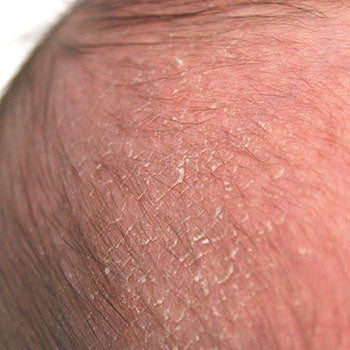
Source: MommyHood101.com
At the other end of the scale, the skin condition can result in extreme redness and a literal cap on the top of the head.

Source: nhs.uk
Symptoms are similar when they appear on other parts of the body.

Source: HomeRemediesForLife.com
How Can You Tell Cradle Cap Apart From Other Conditions?
In some cases, you might not be sure whether your baby has cradle cap or a different skin condition. This is especially true if the cradle cap is occurring somewhere besides your baby’s head, where it most commonly appears. So how can cradle cap be identified?
Cradle cap is just one type of rash that your little one might develop, but it has a few distinguishing features. First, cradle cap often creates small patches of crusty skin that feel hard and rough to the touch. These patches may be raised from your baby’s body in little clumps. And, of course, cradle cap is most likely to form on your baby’s head, face, and neck.
Other skin conditions, like dry skin or eczema, are different from cradle cap is several ways. Both dry skin and eczema typically result in dry, flaky skin that will rub off easily. Cradle cap, on the other hand, is characterized by a buildup of dead skin cells that are stuck to your little one’s skin.
In addition, dry skin and eczema are more likely to be found anywhere on your baby’s body, as opposed to just their head, neck, and face. Finally, cradle cap will feel slightly oily, although rough at the same time, whereas dry skin and eczema will ordinarily feel tender and dry.
What Causes Cradle Cap?
According to the American Academy of Family Physicians (AAFP), about 10 percent of baby boys and 9.5 percent of baby girls develop cradle cap. And although the condition is more or less common, little is definitively known about what exactly causes cradle cap. This is one reason it may be hard to treat or prevent.
Still, there are a number of factors that doctors believe could contribute to your little one developing the condition.
Maternal Hormones
One popular theory holds that the baby’s sebaceous glands (the ones that produce skin oil) aren’t working at full strength yet because of mommy’s hormones (from gestation and nursing).
But don’t feel bad. As we said, cradle cap is extremely common, and it’s not your fault. Your baby’s glands’ overactivity, which happens as a result of your hormones, leads to an excess of oil. When that oil is present, dead skin cells that should be shed off naturally get caught in the oil and, as a result, form clumps.
Doctors believe that the glands sometimes work harder because of the influence of the mother’s hormones that are still present in your baby’s body even after they leave the womb.
That’s just a theory, though. As logical as it sounds, don’t let it change your nursing habits. Your baby’s body will get used to the new environment (hormones included) during the first twelve months of their life.
Yeast Imbalance
A second theory holds that Malassezia, a specific strain of yeast, is the cause of cradle cap. When Malassezia colonizes on the surface of your baby’s skin, redness and inflammation form as your baby’s body fights off the yeast. This may lead to a buildup of sebum and dead skin cells — otherwise known as cradle cap.
Immunodeficiency
Sometimes — though very rarely — generalized cradle cap may be linked to immunodeficiency. Immunodeficiency in your baby is the failure of the immune system to protect your little one’s body from infection. This is due to either the absence or insufficiency of some component process or substance.
If this is the case, there will be other symptoms in addition to just cradle cap, and your doctor can diagnose and treat your child.
Fungal Infection
A third possibility is that cradle cap is the result of a fungal infection. While additional research is needed, some medical professionals believe cradle cap may be related to other fungal skin conditions, like athlete's foot.
Whatever the true cause of cradle cap may be, doctors know for sure that it is not caused by poor hygiene, an allergic reaction, or a bacterial infection.
We also know that it’s a normal condition and absolutely nothing to worry about. One study performed in Australia found that as many as 10 percent of children under five years old have cradle cap at any given time! That’s quite a bit, but the condition normally goes away in about a week with proper treatment.
Are There Any Tests For Cradle Cap?
Unfortunately, no. But if you visit a doctor, he or she will be able to diagnose cradle cap just by looking at your baby’s skin. And that can be relieving during the high-stress days of early parenthood.
Remember, cradle cap is mostly harmless and usually clears up on its own. Often, it goes away by baby’s first birthday, but in some children, it may not clear up until they are between two and four years old.
Still, there are a number of methods you can safely try to aid in the removal of cradle cap at home. Just keep in mind that when dealing with your baby’s delicate skin, it is always important to be careful with the products you use, choosing those that are natural and safe.
Does Cradle Cap Have An Odor?
With mild cradle cap cases, you probably won’t notice an odor. However, if your little one is dealing with a severe case of cradle cap, it’s normal to detect a slight oily scent. This is due to the buildup of oil on your baby’s scalp.
Can You Pick Your Baby’s Cradle Cap?
While it may be tempting to pick and scrape away little pieces of cradle cap yourself, try not to do this. Picking at cradle cap can leave sore patches, making your little one susceptible to infections.
If you start to notice some redness or if the area looks swollen, reach out to your baby’s pediatrician for observation.
What Are The Best Ways To Prevent & Treat Cradle Cap?
1) Bathe Your Baby No More Than Once Per Day

It may be tempting to think that bathing your baby more often will help get rid of cradle cap. However, the opposite is true! Bathing your baby too frequently can dry out their skin, which will cause their sebaceous glands to release excess oil — which may be the reason behind your baby’s cradle cap to begin with!
Bathe your little one once per day at most. Just make sure to clean their diaper area thoroughly when changing dirty diapers. Wipe their bottom with our Cleansing Wipes, which are paraben-free and safe to use on newborns all the way up to adults!
That’s right, mom — you can use these wipes as well since they do a super job of gently removing makeup. Keep a pack of wipes in your diaper bag for your baby and in the bathroom for yourself!
In addition to wiping their bottom with every diaper change, keep your baby’s skin clean with a gentle micellar water, like Mustela's No Rinse Cleansing Water.
Just apply our micellar water to your little one’s skin using a soft cloth, diaper wipe, or cotton pad and then pat dry. There’s no need to rinse it off with water! That convenience makes it great for keeping your little one clean while you’re out-and-about or traveling.
2) Keep Baths Short
When you bathe your squirming babe, keep bath time relatively short. Just as bathing them too frequently will dry out their skin, spending too long in the bath will have the same effect.
To care for your baby’s cradle cap, limit baths to 10 minutes or less. You’ll also want to keep an eye on the temperature of the water. Bath water should be approximately the same as your baby’s body temperature: 98.6 degrees Fahrenheit.
Bathtime might have to be short, but that doesn’t mean it can’t be fun! Pour a little bit of Mustela’s Multi-Sensory Bubble Bath into the bathwater. Your baby will love splashing in the foaming bubbles while our biodegradable bubble bath formula safely and gently cleanses their skin. That’s a win-win for both of you!
Another way to get the most bang for your bath: 2 in 1 Cleansing Gel. Gentle enough for newborns, this baby bath gel will leave their skin feeling soft and smooth without any residue or dryness.
3) Use The Right Baby Shampoo
Before we finish talking about dealing with cradle cap during bath time, it’s important to mention shampoo.
To help reduce the chances of your baby developing cradle cap, wash your baby’s hair and scalp with a gentle shampoo two or three times a week. We recommend Mustela’s Foam Shampoo because it’s formulated to gently cleanse and to rinse away the flakes associated with cradle cap.
Massage the shampoo gently (remember not to pick or peel cradle cap!) onto your little one’s wet head. Leave the shampoo on for a minute or two, then gently rinse their head.
4) Take A Vitamin B Supplement If You’re Nursing
The B vitamin biotin is important for healthy skin. Normally, you get plenty of biotin from your diet. But sometimes, pregnant and nursing moms can develop a deficiency of this important nutrient. Because of the role this vitamin plays in skin maintenance, some believe taking a biotin supplement can help treat cradle cap when the mother has a deficiency.
Before you run out and buy all the biotin on the shelf, keep in mind there’s no hard evidence that this works. At the very least, discuss with your doctor the possibility of taking the supplement before you add it to your daily routine.
5) Brush Your Baby’s Scalp With A Soft Brush
For an added bit of prevention and treatment, we suggest brushing your baby’s scalp with a soft brush while he’s in the bath. Any baby hair brush will do a great job at gently removing the scaly skin. Just massage your baby’s scalp with the brush, but be sure not to pick at the scales (this can cause irritation).
If you can’t get ahold of a soft hairbrush, or if your baby doesn’t like it, you can massage his scalp with a terry cloth towel while drying him off.
If your little one has a head full of tangly hair, spray on our Skin Freshener detangling spray to be able to gently comb through their hair.
6) Apply Baby Oil Before Brushing
If brushing your baby’s scalp with a soft brush doesn’t seem to be working, try adding a drop or two of baby oil before you start brushing. Then, while you brush, you’ll also be working the baby oil into your child’s scalp for a boost of healing and prevention. Remember to be gentle so you don’t further damage your baby’s sensitive skin.
The great thing about baby oil is that it’s multi-purpose! Use it to give your baby a soothing massage, take off your makeup, pull band-aids off, and remove price tag stickers. We told you it’s useful! Check out our article with 17 Ingenious Ways To Use Baby Oil.
7) Use A Humidifier
Humidifiers are wonderful for your baby’s skin. This is true whether or not they have cradle cap! It’s best to place the humidifier in your baby’s nursery, or whichever room they sleep in, and to leave it on while they rest.
Humid air keeps your little one’s skin from drying out. This helps get rid of cradle cap because your baby’s skin won’t release as much sebum when it’s already hydrated and well-moisturized. Since excess sebum is thought to be the cause of cradle cap, less sebum means less cradle cap!
8) Apply Cradle-Cap Specific Products
The last thing you want to do is make your baby’s cradle cap worse as a result of the harsh chemicals found in some infant skin care products. That’s why it’s crucial to use products on your little one that are specifically designed for babies with cradle cap.
Mustela’s Cradle Cap Duo set, for example, includes a foam shampoo and a special cradle cap cream. Both products are made with natural ingredients, meaning there’s no need to worry about harsh chemicals affecting your baby. As we mentioned earlier, the foam shampoo cleanses your baby’s hair and scalp while softening and rinsing away the flakes that are commonly associated with cradle cap.
The cradle cap cream works to prevent and eliminate cradle cap. It also helps soothe any discomfort your little one might be experiencing.
9) Be Patient

Remember that cradle cap is the manifestation of an imbalance inside your baby’s body. You can treat the symptoms (the flaky skin), but it may take a while for the condition to completely disappear. Be patient, and continue using products designed to prevent and treat cradle cap, like Mustela’s Foam Shampoo, to defend against future outbreaks.
You can also try our brand-new Cradle Cap Cream, which we mentioned earlier as part of our Cradle Cap Duo set. Formulated with a patented avocado ingredient and plant-derived borage oil, this fragrance-free cream reduces the appearance of flakes and moisturizes your baby’s scalp.
Using the Cradle Cap Duo to treat your little one’s cradle cap provides the best chance for healing while you wait for it to clear up. But keep in mind that it may take some time. Each case of cradle cap is different. Some may clear up and heal within weeks, while others may take a few months.
10) Consult A Physician
If your baby’s cradle cap doesn’t seem to be getting any better or if it looks infected, visit your doctor or pediatrician. If it’s an extremely bad case of cradle cap, she may prescribe a topical steroid, like hydrocortisone, to help decrease the symptoms.
However, don’t let cradle cap keep you up at night. By following a few simple steps, such as shampooing a few times per week and brushing your baby’s scalp with a soft brush, your baby’s cradle cap will soon disappear.
What To Avoid When Treating Cradle Cap

Always keep in mind that your baby’s skin is incredibly sensitive, so when considering your options for how to get rid of cradle cap, it’s important to avoid using harsh or potentially toxic chemicals.
We understand that reading the ingredient list on a bottle of lotion or baby gel can be pretty overwhelming! To help simplify things, here are four ingredients you should avoid when purchasing baby products. This goes for any baby’s delicate skin, but especially if your little one has cradle cap!
4 Ingredients To Avoid
1) Phenoxyethanol
This synthetically produced chemical is used as a preservative. It fights bacteria growth, which sounds great, but this chemical can irritate your baby’s skin and even potentially damage their nervous system.
2) Parabens
This one might sound familiar to you since parabens are commonly used as preservatives in food and cosmetics. The biggest concern with parabens is that they can disrupt hormone function, which is bad news for your baby’s developing endocrine system.
3) Sulfates
Sulfates give shampoo (and other cosmetic products) that foamy quality that makes us feel so clean. They also help to lift the dirt and oil off our skin. However, sulfates are easily absorbed through the body and can be too harsh on your little one’s skin. They can also cause eye irritation, skin rash, hair loss, and allergic reactions in babies.
4) Alcohol
You might see variants of the word ‘alcohol’ on the ingredient list, and they aren’t all bad. The ones you want to avoid are ethanol and ethyl alcohol since those can be drying and irritating to your baby’s skin.
Now that you know the ingredients to steer away from, here are a few that will help, not harm, your baby! Read more about these nine beneficial ingredients here.
- Aloe vera
- Avocado oil
- Avocado perseose
- Beeswax
- Galactoarabinan
- Jojoba oil
- Olive oil
- Shea butter
- Sunflower seed oil distillate
Natural Cradle Cap Remedies To Avoid
Despite what the list above might make you think, just because a product is free of synthetic chemicals or safe for your adult skin doesn’t mean it’s OK to put on your baby’s skin.
For example, it’s never a good idea to apply undiluted apple cider vinegar, hydrogen peroxide, or essential oils to your baby’s scalp to treat cradle cap. While these are often touted as home remedies for cradle cap (and a host of other conditions), they can be too strong for your baby’s skin and can cause irritation. Instead, opt for baby-friendly products like Mustela’s Foam Shampoo.
Consult your pediatrician before using any and all products on your baby, since certain brands and ingredients can be toxic when absorbed through your little one’s skin. Choose to invest in products that are made with natural ingredients and have been proven as safe for babies — ones free from potentially harsh and threatening chemicals.
Kick Cradle Cap To The Curb

Hopefully we’ve put your mind at ease and answered your questions about cradle cap. While it’s distressing for you as a parent to see your little one with this condition, just remember that it’s temporary and likely isn’t bothersome at all to your baby!
Follow our 10 steps for treating cradle cap and care for your little one’s skin with gentle products, such as Mustela’s Foam Shampoo and Cradle Cap Cream. With the right treatment and a little bit of patience, your baby’s cradle cap will soon be history!


